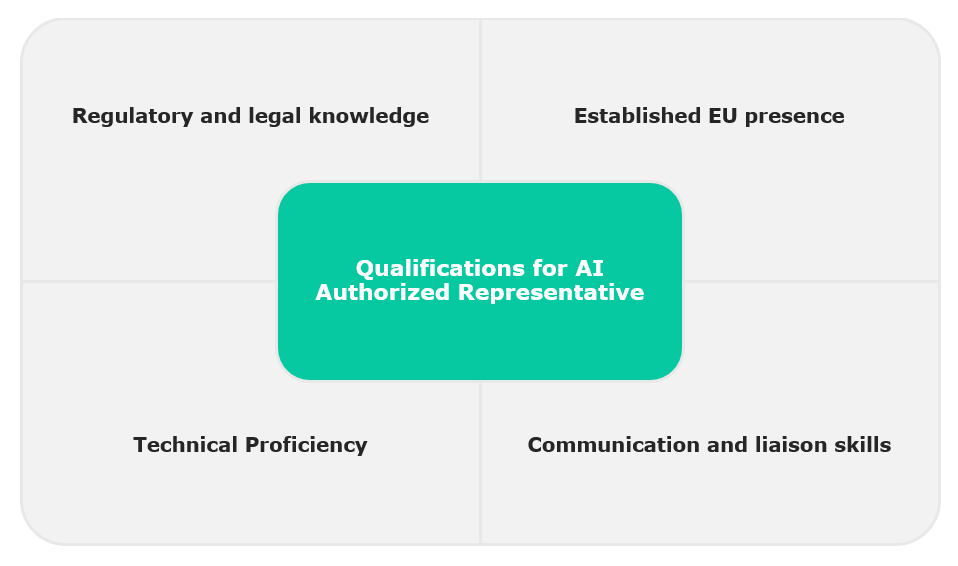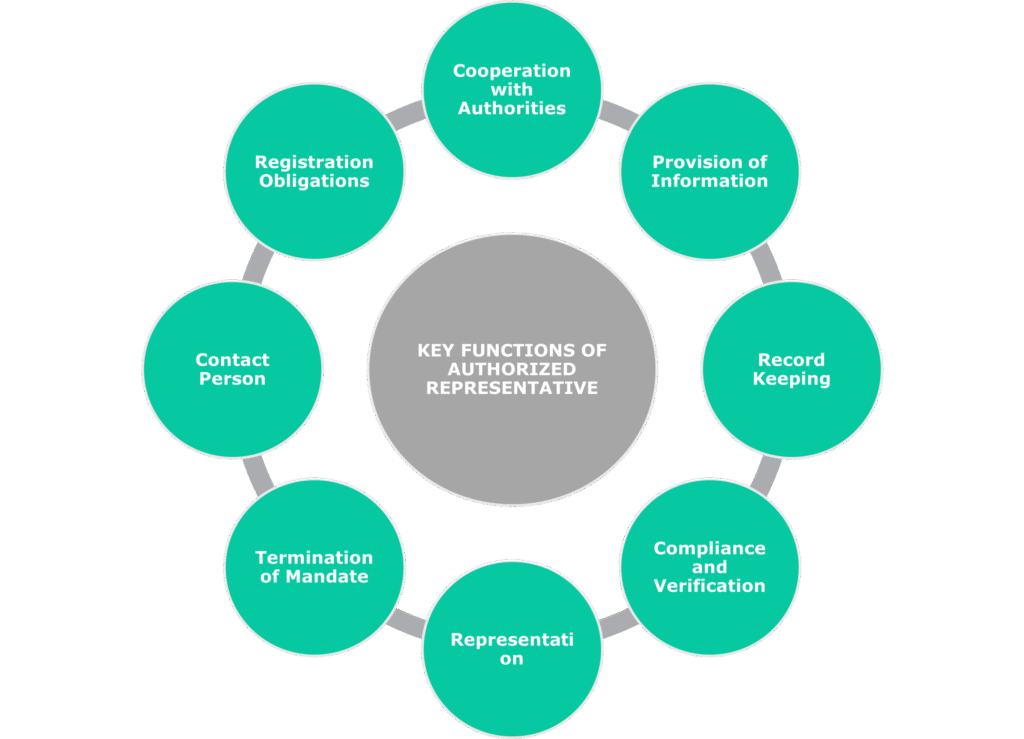Content
The European Union’s Artificial Intelligence Act (AI Act) is reshaping the global artificial intelligence (AI) landscape, setting clear rules for how AI systems enter and operate within the European market. Among its key provisions is the introduction of one of the key roles in the AI value chain, Authorized Representatives (ARs), intermediaries tasked with bridging the gap between non-EU AI providers and EU regulators.
Authorized Representatives are not just a formality, but a compliance necessity. For providers of high-risk AI systems or general-purpose AI models (GPAI) established outside of the EU, the appointment of the AR within the EU is mandatory. These EU-based representatives serve as the official contact point for regulatory authorities, ensuring that obligations under the AI Act are consistently and transparently met.
For global AI providers seeking to enter or scale within the EU market, understanding the role of Authorized Representatives is crucial. In the sections that follow, we provide a business-oriented overview of the ARs under the AI Act, focusing on their functions, strategic importance, and what organizations should consider when appointing one.
1. Why do you need an Authorized Representative Under the EU AI Act?
For companies based outside of the EU, the requirement to appoint an Authorized Representative is not just a legal formality. It is part of a broader regulatory model designed to ensure accountability, facilitate communication with EU authorities, and build trust with European stakeholders. Understanding this framework is key for global AI providers planning to access or expand within the EU market.
A. Rationale Behind the Requirement for Authorized Representatives
The duty to appoint a “representative” within EU territory has long been embedded in Europe’s regulatory frameworks for market participants established outside of the EU. AI Officer is a cornerstone of digital and product safety regulations, appearing in regulations such as the General Data Protection Regulation (GDPR), the Digital Services Act, the NIS2 Directive, and the Data Governance Act, among others.
At its core, this obligation ensures that non-EU businesses operating in the European market have a designated, accessible, and accountable point of contact for regulators and European stakeholders. The AI Act follows this established pattern by requiring certain non-EU providers of high-risk AI systems and general-purpose AI models to designate an Authorized Representative within the EU.
This rationale is not unique to the AI Act. Comparable requirements exist in international data protection and governance laws. For global businesses, the consistency of this approach underscores the importance of appointing an Authorized Representative as both a compliance measure and a practical enabler of market entry.
Under the AI Act, however, the authorized representative takes on additional responsibilities, similar to those in product liability law. In addition to serving as a local point of contact for authorities and stakeholders, the representative is also responsible for contributing to the assurance of product safety and compliance with regulatory requirements.
B. Role and Function of Authorized Representatives Under the EU AI Act
An Authorized Representative acts as the official bridge between non-EU AI providers and relevant EU authorities, including the AI Office. For providers of high-risk AI systems or general-purpose AI models established outside the EU (i.e., based in third countries), appointing the AR within the EU is a prerequisite to market entry. This requirement underscores the importance of a local presence to effectively navigate and comply with the EU’s regulatory framework.
In practice, Authorized Representatives operate as intermediaries between non-EU AI providers and EU authorities mandated to act on behalf of providers. Their role is not symbolic but highly operational – within the scope of their mandate, they ensure that the provider has taken all required measures and possesses the documentation necessary to demonstrate compliance with the strict obligations of the EU AI Act.
According to the EU AI Act, an Authorized Representative may be either an individual or an entity located or established in the EU who have received and accepted a written mandate from the provider of a high-risk AI system or a general-purpose AI model. Their principal duty is to perform and carry out, on behalf of the provider, the obligations and procedural steps prescribed under the EU AI Act.
In essence, an Authorized Representative streamlines regulatory engagement for non-EU providers, safeguards adherence to compliance requirements, and enhances trust and transparency within the EU’s AI ecosystem. For businesses seeking access to Europe, appointing the right AR is not just a compliance checkbox, but a strategic decision that directly influences regulatory readiness and market success.
Practical example: consider a South Korean company that develops an AI-driven medical diagnostic tool classified as a high-risk AI system under the EU AI Act. Before the tool can be marketed in the EU, the company must appoint an EU-based Authorized Representative. This AR will be responsible for engaging with EU regulators, confirming that the provider has completed the required conformity assessments, and verifying that all required documentation is available and accurate. Only after these compliance steps are fulfilled can the medical AI system be lawfully introduced to the European market.
2. When Do Businesses Need to Appoint an Authorized Representative under the AI Act?
The EU AI Act establishes a phased timeline for appointing Authorized Representatives, reflecting the different levels of risk associated with the AI systems. Non-EU providers cannot delay this obligation, as the deadlines are tied directly to market access – without an EU-based representative, their systems cannot be lawfully placed on the Union market.
- By 2 August 2025 → Non-EU providers of general-purpose AI (GPAI) models must appoint an Authorized Representative in the EU before they can introduce their AI models to the EU market.
- By 2 August 2026 → Non-EU providers of high-risk AI systems must appoint an Authorized Representative in the EU before making their AI systems available to EU customers.
This phased implementation gives companies some lead time, but the requirement itself is non-negotiable. For global AI providers, early planning is critical. Delaying the appointment of the AR risks missed deadlines, blocked access to the EU market, and heightened exposure to regulatory scrutiny. Conversely, engaging the AR well in advance allows businesses to streamline compliance efforts, align internal documentation with EU standards, and enter the market with greater confidence.
3. Qualifications Required to Act as an Authorized Representative
The AI Act does not prescribe a formal list of qualifications for the ARs. However, the scope of responsibilities attached to the role makes it clear that the position demands both regulatory knowledge and practical expertise. Simply appointing any entity established in the EU will not be sufficient, as the effectiveness of the AR depends on its ability to carry out compliance functions reliably and competently.
At a minimum, an Authorized Representative should possess:
- Regulatory and legal knowledge – a strong understanding of the AI Act, related EU laws, and the obligations imposed on providers;
- Technical competence – the ability to review and verify EU declarations of conformity and technical documentation, ensuring that the AI system meets regulatory standards, as well as a strong understanding of the technical aspects of the AI systems;
- Communication and liaison skills – the capacity to engage effectively with competent national authorities, respond to information requests, and provide clear documentation when required;
- Local presence in the EU – since the AR must be located/established within the EU, familiarity with EU administrative processes and regulatory culture is essential.
In practice, these requirements mean that many businesses appoint specialized consultants, or compliance organizations. For global AI providers, choosing the appropriate AR is not only about meeting the legal requirements but also about ensuring that compliance obligations are handled proactively, reducing risk, and building credibility with EU regulators.

4. Step-by-step Checklist: Does Your Business Need to Appoint an Authorized Representative in the EU?
Not every AI provider will need to designate an Authorized Representative under the EU AI Act, but for many non-EU businesses, this step is unavoidable. Use the following checklist to determine whether your organization falls under this obligation:
1) Are you a provider of a high-risk AI system or a general-purpose AI (GPAI) model?
Under the AI Act, a provider is any natural or legal person, public authority, agency or other body that develops an AI system or a general-purpose AI model or that has an AI system or a general-purpose AI model developed and places it on the market or puts the AI system into service under its own name or trademark, whether for payment or free of charge. If this describes your business, you should assess whether your product falls into one of the categories that trigger the obligation to appoint an Authorized Representative.
High-risk obligations arise in two ways. First, if your AI system functions as a safety component of a product, or such an AI system itself is a product, and is covered by Annex I of the EU AI Act, then a third-party conformity assessment applies. This includes areas like medical devices, where AI-enabled diagnostic devices are reviewed under strict product safety rules.
Second, if your AI system falls within the sensitive use cases set out in Annex III of the EU AI Act, you are also considered a high-risk provider. These include systems used for biometric identification, managing critical infrastructure, education and vocational training, employment and recruitment, credit scoring and access to essential services, law enforcement, migration and border control, and even the administration of justice or electoral processes.
Finally, providers of general-purpose AI models must also plan for this obligation. While some exemptions apply, any GPAI model that presents systemic risk automatically triggers the requirement to appoint the AR, without exception.
2) Are you offering your AI system product or model on the EU market while being established outside the EU?
If your business is:
- introducing a high-risk AI system or GPAI model onto the EU market, OR making such AI systems or models available in the EU for distribution or use on the EU market during commercial activity, whether sold or provided free of charge; and
- legally established outside of the EU;
Then you are obliged to appoint the Authorized Representative within the EU. This requirement ensures that EU regulators and stakeholders always have a responsible, accountable, and accessible point of contact inside the EU.
3) Does your GPAI model fall outside the open-source exception, or does it present systemic risk?
If you are a provider of a general-purpose AI model that is not genuinely open-source, meaning it is not released under a free licence that allows users to access, modify, and distribute the model, including disclosure of parameters such as weights, architecture, and usage, then you must appoint an Authorized Representative.
Moreover, all GPAI models that are deemed to present systemic risks automatically trigger the AR requirement, without exception. This ensures closer regulatory oversight of large-scale models with far-reaching societal and economic impact.
Checklist for AI Providers – Are you required to appoint the Authorized Representative? |
|
|
|
|
5. Key Responsibilities and Functions of Authorized Representatives
Both types of AI providers are subject to a largely identical set of duties. Most importantly, they must appoint, by written mandate, the Authorized Representative before making their system or model available in the EU.
Considering the AR role at a high level, the AR acts as a key point of contact within the EU, ensuring that all documentation demonstrating compliance with the high-risk AI system or general-purpose AI model with the EU AI Act is verified, maintained, and available to EU regulators. They are responsible for receiving serious incident reports, responding to regulatory requests, and, where necessary, registering high-risk AI systems in the EU database.
Crucially, the ARs do not merely store documents; they have a duty to step into the provider’s role if required. If the AR considers or has a reason to consider the provider to be acting contrary to its obligations pursuant to the AI Act, it must terminate the mandate and immediately inform the relevant market surveillance authority, as well as, where applicable, the relevant notified body, about the termination of the mandate and the reasons.

Example: Imagine a Canadian company developing an AI-powered tool for biometric identification, classified as a high-risk AI system under the EU AI Act. Before this tool can be marketed in Europe, the company must appoint an Authorized Representative established within the EU. The AR will not only confirm that the company has appropriate documentation and measures in place that assure that the AI system meets all regulatory requirements but will also act as the first point of contact if EU regulators raise questions or initiate an investigation. Should the AR discover that the provider is not fulfilling its obligations, it would be required to end the mandate and immediately inform the relevant authorities, ensuring that compliance gaps do not go unnoticed.
For a comparative overview of the obligations applying specifically to high-risk AI systems and GPAI models, please see the table below.
Comparative Overview of the Authorized Representative’s Obligations | |
AR of GPAI Provider | AR of High-Risk AI Provider |
· Verify that the technical documentation has been drawn up and that compliance with prescribed obligations is fulfilled | · Verify that the EU declaration of conformity and the technical documentation have been drawn up, and that the provider has carried out an appropriate conformity assessment procedure |
· Retain relevant documentation and the provider’s contact details for 10 years after the model enters the market | · Retain relevant documentation and the provider’s contact details for 10 years after the AI system is placed on the market or put into service |
· Provide the AI Office, upon a reasoned request, with all necessary information to demonstrate compliance | · Provide the competent authorities, upon a reasoned request, with all necessary information and documentation to demonstrate the conformity of the high-risk AI system with the applicable requirements |
· Cooperate with the AI Office and competent authorities, upon reasoned request, in any action they take in relation to the GPAI model, including when the model is integrated into AI systems placed on the market or put into service in the EU. | · Cooperate with competent authorities, upon a reasoned request, in any action taken in relation to the high-risk AI system, to reduce and mitigate the risks posed by the high-risk AI system. |
· Serve as the point of contact for the AI Office and competent authorities to address compliance issues on behalf of the provider. | · Where applicable, ensure that the AI system is correctly registered in the relevant EU database, or, if the provider handles the registration directly, verify that the submitted information is correct. |
· Terminate the mandate and immediately inform the AI Office of the termination of the mandate and the reason thereof, if AR considers or has reason to consider the provider to be acting contrary to its prescribed obligations. | · Terminate the mandate and immediately inform the relevant market surveillance authority and, where applicable, the relevant notified body, about the termination of the mandate and the reason thereafter, whether AR considers or has reason to consider the provider to be acting contrary to its prescribed obligations. |
6. What Are the Consequences of Failing to Appoint the Authorized Representative?
Not appointing the Authorized Representative is treated as a case of “formal non-compliance” under the EU AI Act. If this situation is not remedied, competent authorities have the authority to restrict or even prohibit the affected high-risk AI system or GPAI model. In practice, this means that a business could be blocked from market entry altogether.
Beyond market restrictions, the failure to appoint the AR can also lead to administrative fines of up to EUR 15 million or up to 3% of total worldwide annual turnover. For non-EU providers, this transforms what might seem like a procedural requirement into a serious financial and strategic risk.
Importantly, the responsibility does not stop with the provider. Authorized Representatives themselves may also face penalties if they do not fulfil their duties properly, since they are considered “operators” under the EU AI Act.
7. How to Ensure Compliance and Select the Right Authorized Representative?
Appointing an Authorized Representative is not just a box-ticking exercise under the EU AI Act, but a critical step in securing long-term access to the EU market. To comply effectively, providers should focus on three core actions:
- Appointment of an Authorized Representative – issuance of a written mandate to an EU-based representative, setting out their responsibilities clearly and unambiguously.
- Preparation and Maintenance of Technical Documentation – compilation of the documentation required under the AI Act, and retention for at least ten years to demonstrate ongoing compliance.
- Building Efficient Communication Channels – establishment of seamless lines of communication with the AR to ensure rapid responses to regulatory requests and smooth handling of compliance matters.
But compliance is only half the story. The quality of the Authorized Representative will directly impact the ease and reliability of businesses’ market presence. When choosing the AR, businesses should prioritize:
- Independence – ensuring the AR operates without conflicts of interest in relation to the company.
- Expertise – proven knowledge of EU regulatory frameworks and AI compliance obligations.
- Responsiveness – ability to serve as a proactive intermediary with EU regulators.
- Relevant industry experience – practical understanding of operating in tightly regulated EU sectors.
8. Strengthening Market Access Through Authorized Representatives
The EU AI Act makes the appointment of the Authorized Representative a decisive factor for non-EU providers seeking entry into the EU market. Far from being a procedural formality, the AR functions as a trusted intermediary with regulators, ensuring documentation, conformity, and communication obligations are properly managed.
For providers of high-risk AI systems and GPAI models, choosing the right AR is both a compliance safeguard and a strategic advantage. Companies that act early and select representatives with proven expertise and independence will minimize regulatory risk, avoid costly delays, and build stronger trust with EU stakeholders.
Looking ahead, the role of Authorized Representatives will only grow in importance as regulatory enforcement intensifies. Businesses that integrate the AR into their broader compliance and governance strategies will not only meet legal requirements but also strengthen resilience, credibility, and competitiveness in the EU AI ecosystem.
Take the Fastest Path to
Audit-Ready Compliance
Build trust, stay on top of your game and comply at a fraction of a cost
If your organization is working to meet the requirements of the new EU AI Act, Whisperly can help you approach compliance with clarity and structure. The platform brings together practical AI governance software and expert support to make complex obligations easier to manage, from defining roles and keeping documentation to assessing risks, monitoring systems, and preparing reports.
Whether you’re building or deploying high-risk AI systems or GPAI, Whisperly provides a grounded, transparent way to stay compliant without disrupting your innovation process. Alongside our AI governance services, Whisperly’s EU AI Act compliance and governance software translates regulatory requirements into usable workflows, helps you maintain full visibility over your AI systems, and supports a culture of accountability and trust with regulators and customers.





